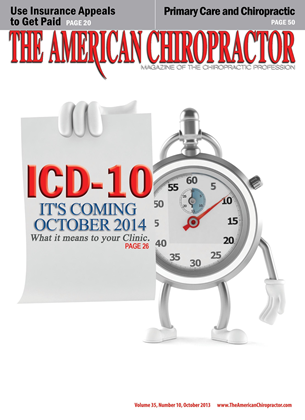H ere's a study from last year that's worth discussing. The authors compared clinical outcomes in a fairly large group of both acute and chronic neck pain patients. Their conclusions arc simple, straightforward, and. unfortunately, all too likely to be ignored. The Facts: a. The authors looked for predictors of positive outcomes in cases of neck pain that sought chiropractic care. b. This was a prospective study of 529 consecutive cases of neck pain of any duration with a three-month follow-up. c. Patients included in the study were over the age of 18. suf fering from neck pain, and had not received any form of chiro practic or manual therapy in the three months prior to joining the study. Patients who exhibited any contraindications to chiropractic manipulative care were excluded from the study. d. Patients were subdivided into two groups according to the duration of their symptoms: 1) acute pain of less than four weeks duration, and 2) chronic pain of greater than three months. e. Evaluation methods consisted of self-reported pain using both a numerical pain rating scale and the Bournemouth question naire, along with a third instrument called the Patient Global Impression of Change (PGIC) scale. c. Active members of the Association of Swiss Chiropractors treated all of the patients. f. The authors were not able to determine any predictors of positive outcome at one week of care. g. However, at one month and at three months, the most consis tent predictor of positive outcome was that the patient reported significant improvement early on in care. h. Both acute and chronic pain patients improved at all time points, but improvements were significantly greater for acute pain patients even though they were the group who reported the greatest initial levels of pain and disability. Take Home: Although acute pain patients may have greater initial pain and disability, they arc likely to respond better than more chronic patients. Patients who respond early in the care process are signifi cantly more likely to have longer-term positive outcomes as well. Discussion: On the one hand, much of this seems in keeping with common sense. Acute pain patients arc more likely to respond well, simply because their problems arc less firmly entrenched than those of chronic pain patients. Of course, this also is in keeping with other studies that have indicated that chiropractic adjustment/manipulation seems to work better with acute spinal pain than with chronic pain. Additionally, the study also tells us that patients who respond early arc likely to also respond best over the longer term. Brilliant, eh? Again, it would seem illogical to expect otherwise, but then that's why we need studies like this one. I suspect many doctors might be critical that the study only followed patients for three months. Mam practitioners might argue that more care is justified for chronic pain patients and its noteworthy that most chronic patients did respond, just not as well. Consequently, some doctors will no doubt be tempted to keep chronic pain patients under care hoping that more care will ultimately produce better results. Maybe they're right, but the point is that we don't really know. What we do know, though, is that the best indicators of whether neck pain patients arc likely to respond well over the long haul arc: a) acute history of pain and b) symptomatic improvement within the first four weeks or treatment. Unlike a number of other papers that have indicated that chronic pain doesn't respond well to chiropractic care, this study suggests tliat a trial period of care, for at least a month or so. maybe reasonable. The first month of care should give a reasonable idea of whether or not the patient is likely to benefit from further treatment. Reference: Peterson C. Bolton J. Humphreys BK. Predictors of outcome in neck pain patients undergoing chiropractic care: comparison of acute and chronic patients. ChiroprManThcrap. 2012:20:27. Link to Abstract: http://www.ncbi.nlm.nih.gov/pubnicd/22920497 Dr. Mark R Payne. Phenix City. AI. is Editor ofSci-enceInBrief.com, a scientific literature review for busy chiropractors. He is also President of A latlin A Ifg Inc. a manufacturer of postural rehabilitation products since 1988. Subscription to ScienceInBrief.com is FREE to doctors of chiropractic and chiropractic students. Re- views of relevant scientific articles are emailed weekly to subscribers.
 View Full Issue
View Full Issue









